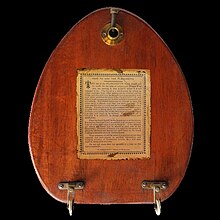Planchette (esoteric)
The planchette is an aid of spiritualism or occultism for automatic writing that is used to receive alleged messages from " spirits " from other worlds. The unconscious reactions of the medium that expresses its unconscious wishes or fears are recorded. Automatic writing was particularly popular in salons in the 19th century.
functionality
The original shape of the planchette was made in France between 1853 and 1856 and has been a great sales success in the USA since 1868, where the device was sold by a toy manufacturer through bookstores. It is a square or oval board that stands on two rollers and uses a pen as a third leg, which is guided with the tip down through a hole in the board and is attached by a clamping or screwing device. The user - a medium or test person - places the planchette on a sheet of paper, places his hand on the board and makes it glide with slight movements, so that a trace of writing is created on the sheet that is hidden from his view during the writing process through the board . The purpose is to create writing on the paper that is controlled as little as possible by consciously controlled hand movements of the user.
Automatic writing
The planchette was not only for spiritualistic purposes and board games used, but is intended for psychological experiments and poets such as Filippo Tommaso Marinetti have been used for literary experiments with automatic writing.
Value of the information obtained
The information obtained through automatic writing is usually very confused. The writing is difficult to decipher, sometimes unrecognizable, and the sentences are often only made up of incoherent fragments.
etymology
The invention of the planchette is backed by Lewis Spence, an alleged French spiritist named “M. Planchette "attributed. In fact, the name could simply be traced back to the fact that planchette is the French word for “ little board”.
The planchette also describes the mostly heart-shaped pointer on the Ouija board, which is manually directed to prefabricated letters, numbers or whole words.
Remarks
- ^ Hans-Christian Kossak : Hypnosis. Textbook for psychotherapists and doctors. Belz Verlag, Weinheim, Basel 3. Corr. Edition 1997. ISBN 978-3-8289-5270-6 . P. 244.
- ^ Hans-Christian Kossak: Hypnosis. Textbook for psychotherapists and doctors. Belz Verlag, Weinheim, Basel 3. Corr. Edition 1997. ISBN 978-3-8289-5270-6 . P. 244.
- ↑ Marc S. Micale, The Modernist Mind: A Map , in: ders. (Ed.), The Mind of Modernism: Medicine, Psychology, and the Cultural Arts in Europe and America, 1880-1940 , Stanford University Press, Stanford 2004 , Pp. 1-19, p. 15, cf. also Lawrence Rainey: Shock Effects: Marinetti, Pathology, and Italian Avant-Garde Poetics , ibid, pp. 197-213
- ^ Hans-Christian Kossak: Hypnosis. Textbook for psychotherapists and doctors. Belz Verlag, Weinheim, Basel 3. Corr. Edition 1997. ISBN 978-3-8289-5270-6 . P. 244.
literature
- Lewis Spence: An Encyclopaedia of Occultism . Routledge, London 1920; Repr. Courier Dover Publications, Mineola (NY) 2003, pp. 324-325

